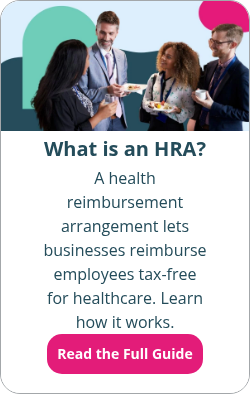What employers need to know about HRA debit cards
By Elizabeth Walker on June 3, 2024 at 8:45 AM
In today's world, debit cards are among the most popular forms of payment for consumer goods. They allow you to buy items online and in retail stores much quicker than cash or other methods.
Given that most people are familiar with debit cards and how they work, you may be wondering if you can give your employees a debit card to use with their health reimbursement arrangement (HRA) instead of processing reimbursements. While some HRA administrators offer this option, HRA debit cards aren’t without their downsides.
In this article, we'll cover everything employers need to know about HRA debit cards and how PeopleKeep can help you administer your health benefit compliantly.
Takeaways from this blog post:
- HRA debit cards allow employees to access their HRA allowance to pay for healthcare expenses without fronting the cost out-of-pocket.
- HRA debit cards have several disadvantages, such as requiring employees to submit manual claims, not being accepted at all locations, and making HRA compliance and personalization more challenging for employers.
- Benefits administration software is a more efficient option for managing an HRA quickly and compliantly.
How do HRAs work?
Before diving into HRA debit cards, let’s review how HRAs work. An HRA is a customizable benefit employers offer employees to help them pay for their healthcare. With this health benefit, you can reimburse your staff tax-free for qualified out-of-pocket medical expenses. Depending on the type of HRA you choose, you can even reimburse your employees for their individual health insurance premiums.
You’ll start by setting a monthly allowance that your employees and their eligible dependents can use to spend on medical care. Once an employee incurs an eligible covered expense and you approve the purchase, you reimburse them up to your set allowance amount.
Unlike a health savings account (HSA), which allows employees to contribute to an account for future medical expenses, HRAs are employer-owned, meaning only you can fund it. Unused allowance amounts roll over monthly until the end of the year, but any unused HRA funds stay with you when employees leave your company.
The following are three types of HRAs you can offer with PeopleKeep:
- The qualified small employer HRA (QSEHRA): A QSEHRA is for organizations with fewer than 50 full-time equivalent employees (FTEs) that don’t offer a group health or ancillary plan. While the IRS sets maximum annual contribution limits, there are no minimum limits. Employees must have a health plan with minimum essential coverage (MEC) to participate in a QSEHRA.
- The individual coverage HRA (ICHRA): An ICHRA works similarly to the QSEHRA, but it’s for employers of all sizes and has no maximum contribution limits. For added flexibility, you can vary your allowances by job-based employee classes. Employees can opt in or out of an ICHRA, depending on affordability. However, if they opt-in, they must have a qualifying form of individual health coverage to participate.
- The group coverage HRA (GCHRA), or integrated HRA: If you have a traditional group health plan, you can pair it with a GCHRA. With this type of HRA, you can reimburse your employees enrolled in your group plan for out-of-pocket expenses their policy doesn’t fully cover, like copays and deductibles. GCHRAs have no maximum contribution limits, are available for employers of any size, and have employee class customization options.
By offering a personalized HRA, your employees will have better control over their healthcare and finances.
How does an HRA debit card work?
An HRA debit card allows employees to access their HRA allowance immediately to pay for healthcare expenses instead of paying out-of-pocket and getting reimbursed later.
Employees can use the card whenever they incur an eligible expense. They may need to submit documentation showing they purchased a qualified service or item. However, they won’t have to use their personal funds to pay for actual expenses out-of-pocket first and wait to receive reimbursement.
Depending on the issuer, your employees may need to create a personal identification number (PIN) to use a physical card. However, virtual cards are also an option. In either case, employees can use their HRA funds to pay for their online transactions.
Some HRA cards will only work if your employees use them to purchase eligible items according to IRS guidelines and their benefit plan documents. To avoid declined purchases, employees shouldn’t buy ineligible items alongside approved ones in the same transaction.
Downsides of using HRA cards
While using HRA cards may seem like a convenient option, they come with some hassles that make them less attractive.
Let’s go over a few disadvantages you need to know before offering HRA debit cards to your employees.
They may require employers to pre-fund an account
One of the benefits of an HRA is that employers don’t need to pre-fund an account. They only reimburse employees when they incur an eligible expense. However, with an HRA debit card, your service provider may require you to pre-fund an account so your employees can use their cards on qualified expenses.
They can require employees to submit manual claims
Depending on the issuer, employees may have to submit a manual claim form with proper substantiation each time they use their HRA card.
Acceptable forms of “proper substantiation” will depend on what your worker is trying to buy. If they want to use their card for over-the-counter drugs, they'll need a prescription from a medical doctor and an itemized receipt to submit to the third-party administrator (TPA).
While some IIAS-compliant pharmacies can bypass the manual claim requirement, most benefits providers still require it, making things confusing for your workers.
If your employees don't submit the required information, you have to get it from them for their transactions to be IRS-compliant—otherwise, they may have to pay back whatever expenses they can’t substantiate.
Additionally, certain service providers still require random documentation checks to ensure employees use their cards correctly. This can create problems if employees can use their allowances on ineligible items.
Not everyone accepts HRA debit cards
Even if your employee is trying to pay for an HRA-qualified product or service, some places won’t allow them to use their HRA debit card. That’s because doctor offices, pharmacies, and other medical providers aren’t legally required to accept HRA cards.
They may allow employees to purchase ineligible items and services
To make matters more complicated, some places will accept your HRA debit card even if you’re buying items that aren’t HRA-qualified.
For example, let’s say your employee picks up some snacks at the pharmacy while waiting to pick up a prescription drug, and they accidentally swipe their HRA card instead of their personal debit card. That purchase will go through, and your employee will be responsible for returning that money to their account. IRS Notice 2017-67 explains that an eligible employee can repay excess or mistaken reimbursements to avoid noncompliance1.
If employees successfully use their HRA debit cards on ineligible expenses without you catching it, it could put your entire HRA benefit at risk.
Notice 2017-67 states that if an HRA mistakenly reimburses an employee for an unsubstantiated expense, “the arrangement fails to satisfy the requirements for the payments to be excluded from the employee’s income, and all payments to all employees under the arrangement, substantiated and unsubstantiated, on or after the date the mistaken reimbursement was made, become taxable.”
If the employee doesn’t repay the incorrect reimbursement from the HRA debit card, you must report that amount as taxable income on their Form W-2. This is why reviewing employee documentation and only reimbursing them when they incur an eligible expense is critical.
HRA debit cards can't process payments over the allowance amount
What happens if your employee has a charge that’s more than the amount remaining on their HRA debit card? The card simply gets declined.
So even if they still have $100 left on their card, the card won't process the payment if they try to pay for an eligible item that costs $115. While your employees can pay for the charge out of pocket and submit it for reimbursement later, they’re just out of luck if they don’t have another payment method with them at the time.
This means employees must keep a close eye on how much money is left on their HRA debit card; otherwise, they could end up needing another way to pay for what they need.
HRA compliance and personalization can be more challenging
Employers have all sorts of options to personalize an HRA for their employees’ unique needs. However, debit card providers don’t always allow these personalizations.
For example, with an HRA debit card, you may be unable to vary the allowance amounts for different classes of employees if you’re offering an ICHRA or GCHRA. So, if you want your full-time employees to have a specific allowance while your part-time employees have another, an HRA debit card may not work.
What’s more, if you want to offer a premium-only HRA that doesn’t cover any additional medical costs, employers may be unable to restrict the card’s usage to allow for this. This means employees can potentially use unused funds on ineligible items.
How PeopleKeep can help you administer your HRA
Now that you understand some of the hidden complications associated with HRA debit cards, let’s talk about a quick and easy way to manage your benefit—HRA administration software.
If you like the convenience of HRA debit cards but want to avoid the complications and compliance headaches they may bring, HRA administration software may be the answer. An excellent administrative tool will give your benefit plan administrator the training and ongoing support needed to keep your HRA compliant and functioning smoothly.
PeopleKeep's HRA administration platform helps employers of all sizes manage their benefits in minutes per month. We automate time-consuming tasks like preparing and updating plan documents, reviewing employee claims for reimbursement, and following compliance regulations so that you can focus on other aspects of your business.
Our easy-to-use platform makes it simple for employees to browse eligible expenses, check their available allowances, and upload documents to receive reimbursement. Plus, our award-winning customer support team is available to help your employees with any questions or concerns they may have along the way.
Conclusion
HRA debit cards may seem simple and convenient for your employees to access their benefit funds. However, you must consider the potential downside before offering them at your organization.
Luckily, using HRA administration software gives you the convenience and flexibility you need without the hassle that HRA debit cards can bring. If you're looking to offer personalized and flexible HRA to reimburse your employees’ medical expenses, PeopleKeep can help. Our benefits administration platform makes it easy for all employers to set up and manage their HRA compliantly.
This blog article was originally published on February 8, 2021. It was last updated on June 3, 2024.
Check out more resources
See these related articles

Can I have an HRA and an FSA at the same time?
Learn if you can have an HRA and an FSA at the same time. Understand the rules, benefits, and how these accounts can work together for healthcare costs.

HRAs and W-2 annual reporting
Learn about HRA W-2 annual reporting requirements. Understand what employers need to include on employees' W-2 forms for HRA compliance.

Offering stipends vs. salary increases
Employees increasingly desire added benefits and perks over yearly wage increases. But, what's the difference between stipends and salary increases?



